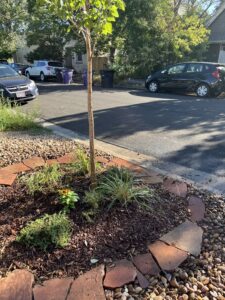The term native is increasingly being used in horticulture and tree planting practices, but what…
Ditch the Rocks: How One Homeowner Created a Thriving Environment for Her Tree
Jan loves trees. She always has. But she didn’t really dig in and learn to care for them herself until she moved into her Athmar Park home. The home was great, but the mostly un-landscaped double lot did not give off the homey feel of her childhood, where she had been surrounded by trees. That’s when her love for trees began to take root in a new direction.
“I had heard about The Park People’s Community Forester program and even signed up for the classes so I could figure out what trees would be best to plant in our barren space,” reminisced Jan.
Her effort to reforest the front yard became even more exciting when she learned about the free trees offered by Denver’s Office of the City Forester.
“The process of applying is simple,” she said. In 2017, Jan received her first free tree. It didn’t last. She called for a replacement. After a strong start, the second tree sadly did not survive. After these two unexpected losses in the same location, Jan reached out to Denver’s Office of the City Forester for extra help. Because of her experience as a Community Forester, Jan initially worried there might be pathogens in the soil, or some disease process that was killing the trees.

The Forestry team immediately identified the problem as not enough water – but not for lack of trying.
“I was surprised because I had watered the tree faithfully for the first several months,” said Jan. Instead, it was the rocks around the tree that were overheating it, causing it to lose water fast.
The Forestry team advised a quick, easy fix:
- Pull back the gravel away from the tree
- Mulch the tree appropriately (no mulch “volcanoes” necessary)
- Use a tree watering bag that zips around the trunk
Upon receiving her current tree, which is now thriving in its new environment, Jan says, “I have pledged to care for it and provide it a good life!”
Landscape Materials Make the Difference
Jan’s story proves an important point: when it comes to environmental and canopy considerations, there are better options than others when it comes to surface treatments, or materials you use to landscape.
Here are a few reminders on what’s best and worst when it comes to creating an environment for thriving trees and plants at your home:
BEST:
- Organic mulch (woodchips, bark, straw, grass clippings, seed hulls) directly on top of the soil
- Improves water penetration and air movement
- Reduces surface evaporation and conserves soil moisture
- Great at controlling weeds, very attractive, breaks down gradually
- Low water turf
- Healthy lawns benefit the environment! There are low water options that replace traditional bluegrass and provide a walkable alternative such as a Blue Grama, Buffalograss or Dog Tuff Grass.
- Lawn grass helps clean the air, trap carbon dioxide, reduce erosion from stormwater, runoff, improve soil and reduce temperatures
- Keep the turf away from the tree base to prevent trimming or mower damage
- Alternatives to landscape fabric (beneath mulch)
- Healthy plant coverage is the best
- Consider incorporating plants like Creeping Sand Cherry, ornamental grasses, Gro-low Fragrant Sumac and Ice Plant.
WORST:
- Rock, stone, gravel, concrete and asphalt
- Create inhospitable conditions for plants and trees
- Retain heat and contribute to heat island effect
- Transfer heat to buildings and utilities
- Makes you ineligible to receive a free tree from the City of Denver in the future!
- Artificial turf
- Doesn’t provide the cooling effect of a living lawn and can get very hot on sunny days
- Does not allow water to infiltrate underlying soil
- Makes you ineligible to receive a free tree from the City of Denver in the future!
- Landscape fabric or plastic
- Prevents water from getting to plant roots and detrimental to plant health
- Restricts air and water movement
- Not needed beneath correctly applied mulch
- Can actually encourage weed growth after time!
Questions about receiving a free tree? Read more about our program. Questions about why your tree isn’t thriving in its current environment? Check out our tree care FAQs.
